Physical Address
304 North Cardinal St.
Dorchester Center, MA 02124
The author wishes to thank Dr. Laura W. Lamps for her work on prior editions of the chapter.
Gastrointestinal (GI) infections are a major cause of morbidity and mortality worldwide. As the number of transplant patients and those with other immunocompromising conditions increases, and as global urbanization and transcontinental travel become more frequent, the surgical pathologist must be familiar with infectious diseases that were once limited to tropical regions of the world or the realm of esoterica.
The goal of the surgical pathologist in evaluating GI specimens for infectious colitis is two-fold. First, acute self-limited processes and infectious processes must be differentiated from chronic idiopathic inflammatory bowel disease (IBD)—ulcerative colitis (UC) or Crohn’s disease (CD) ( Table 4.1 ). Second, attempts must be made to identify the specific infecting organisms. In recent years, histochemical stains, immunohistochemistry, and molecular analysis have expanded the surgical pathologist’s ability to diagnose infectious processes. As these techniques have evolved, our knowledge of the specific histological patterns of inflammation related to various organisms has also increased.
| Features | CMV | Adenovirus | HSV |
|---|---|---|---|
| Cell involved | Stromal and endothelial cells, macrophages, rarely epithelial cells of the upper gastrointestinal tract | Epithelial only—either surface epithelial cells or goblet cells in colon | Epithelial cells, usually squamous |
| Location of inclusion | Nucleus and cytoplasm | Nucleus | Nucleus |
| Characteristics of inclusion | “Owl’s-eye” morphology in nucleus, basophilic or eosinophilic and granular in cytoplasm | Basophilic “smudge cell” replacing nucleus most common, rarely, acidophilic inclusions with halos (Cowdry type A) | Acidophilic with clear halo and peripheral chromatin margination (Cowdry type A) or blue and homogeneous with “ground-glass” appearance (Cowdry type B) |
| Associated changes | Cellular enlargement, apoptosis, mixed inflammatory infiltrate, vasculitis | Surface cell disarray, loss of orientation, apoptosis, cells not enlarged | Sloughing of epithelial cells, neutrophil and macrophage-rich infiltrate, multinucleated cells common |
Most enteric infections are self-limited. Patients who undergo endoscopic biopsies usually have chronic or debilitating diarrhea or systemic symptoms, or they are immunocompromised. A discussion with the gastroenterologist regarding symptomatology and colonoscopic findings, as well as knowledge of the patient’s travel history, dietary habits, sexual practices, and immune status, can aid the evaluation of biopsies for infectious diseases.
The type of viral infection and the manifestations of disease vary with the site of infection and the immune status of the patient. Viral gastroenteritis results from a host of pathogens; those likely to be encountered in surgical pathology practice are emphasized here.
Primary cytomegalovirus (CMV) infections in immunocompetent persons are usually asymptomatic. CMV infection may develop anywhere in the GI tract, from mouth to anus, in both immunocompromised and immunocompetent persons. More than 50% of the adult population is seropositive, but infection is latent in most immunocompetent individuals. CMV is best known as an opportunistic pathogen in patients with a suppressed immune system, most commonly in those with the acquired immunodeficiency syndrome (AIDS) and in solid organ or bone marrow transplant recipients.
When symptomatic disease occurs in immunocompetent hosts, it is usually self-limited and produces a mononucleosis-like syndrome. GI involvement is subclinical in most cases. Indeed, symptomatic patients are often elderly and prove to have underlying malignancies or hematological disorders that compromise their immune systems.
Symptoms vary with site of infection. Colitis causes diarrhea (either bloody or watery), abdominal pain, fever, and weight loss. Patients with esophageal infection often have dysphagia and odynophagia. A rare, but important, entity associated with pediatric CMV infection is hypertrophic gastropathy and protein-losing enteropathy resembling Ménétrier’s disease. CMV infection is an uncommon but well-characterized cause of segmental intestinal ischemia.
CMV reactivation may be superimposed on chronic GI diseases such as UC and CD. In such cases, CMV superinfection is associated with exacerbations of the underlying disease, steroid-refractory disease, toxic megacolon, and a higher mortality rate. Reactivation is particularly associated with steroid-refractory disease, and, thus, some authorities recommend routine immunohistochemical evaluation for CMV in biopsies from patients with steroid-refractory UC. ,
CMV causes a remarkable variety of gross lesions. Ulceration is the most common; the ulcers may be single or multiple and superficial or deep. They can be quite large (>10 cm), and often have a well-circumscribed, “punched-out” appearance ( Fig. 4.1 ). Segmental ulcerative lesions and linear ulcers may mimic CD. Other gross lesions include mucosal hemorrhage, pseudomembranes, and inflammatory polyps or masses. ,
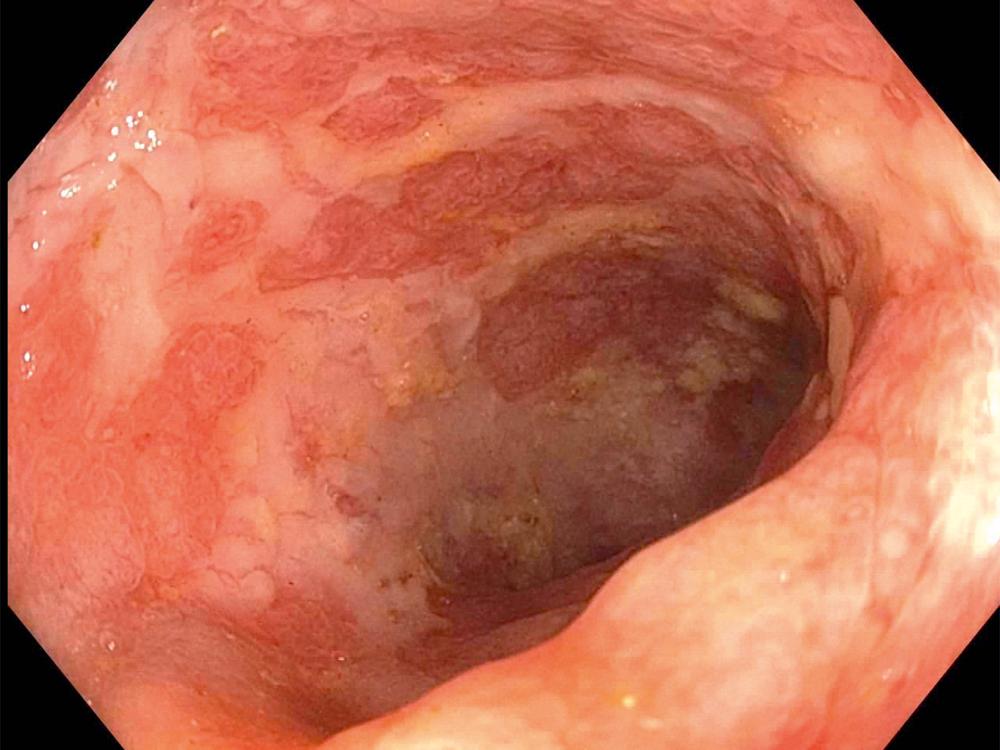
The histological spectrum of CMV infection ranges from minimal inflammation to deep ulcers with prominent granulation tissue and necrosis. Frequently observed histological features include mucosal ulceration, a neutrophil-rich mixed inflammatory infiltrate, and cryptitis of glandular epithelium. Crypt abscesses, crypt atrophy and loss, and numerous apoptotic enterocytes may be seen as well. CMV-associated ischemia features vasculitis with numerous endothelial viral inclusions associated with inflammation, necrosis, and thrombosis of the affected vessel.
Infected cells show both nuclear and cytoplasmic enlargement (hence the name, “cytomegalovirus”) ( Fig. 4.2A ). Characteristic “owl’s-eye” intranuclear viral inclusions and granular intracytoplasmic inclusions may be seen on routine hematoxylin and eosin (H&E) preparations (see Fig. 4.2B,C ). Inclusions are preferentially found in endothelial cells, stromal cells, macrophages, and, rarely, in glandular epithelial cells, particularly in the upper GI tract ( Fig. 4.3 ). In contrast to adenovirus or herpes, CMV inclusions are often found deep within ulcer bases rather than at the edges of ulcers or in the superficial mucosa. Adjacent nuclei may be enlarged, appear smudged, or have a “ground-glass” appearance, but they lack typical inclusions. Characteristic inclusions with virtually no associated inflammatory reaction may occur in severely immunocompromised patients.
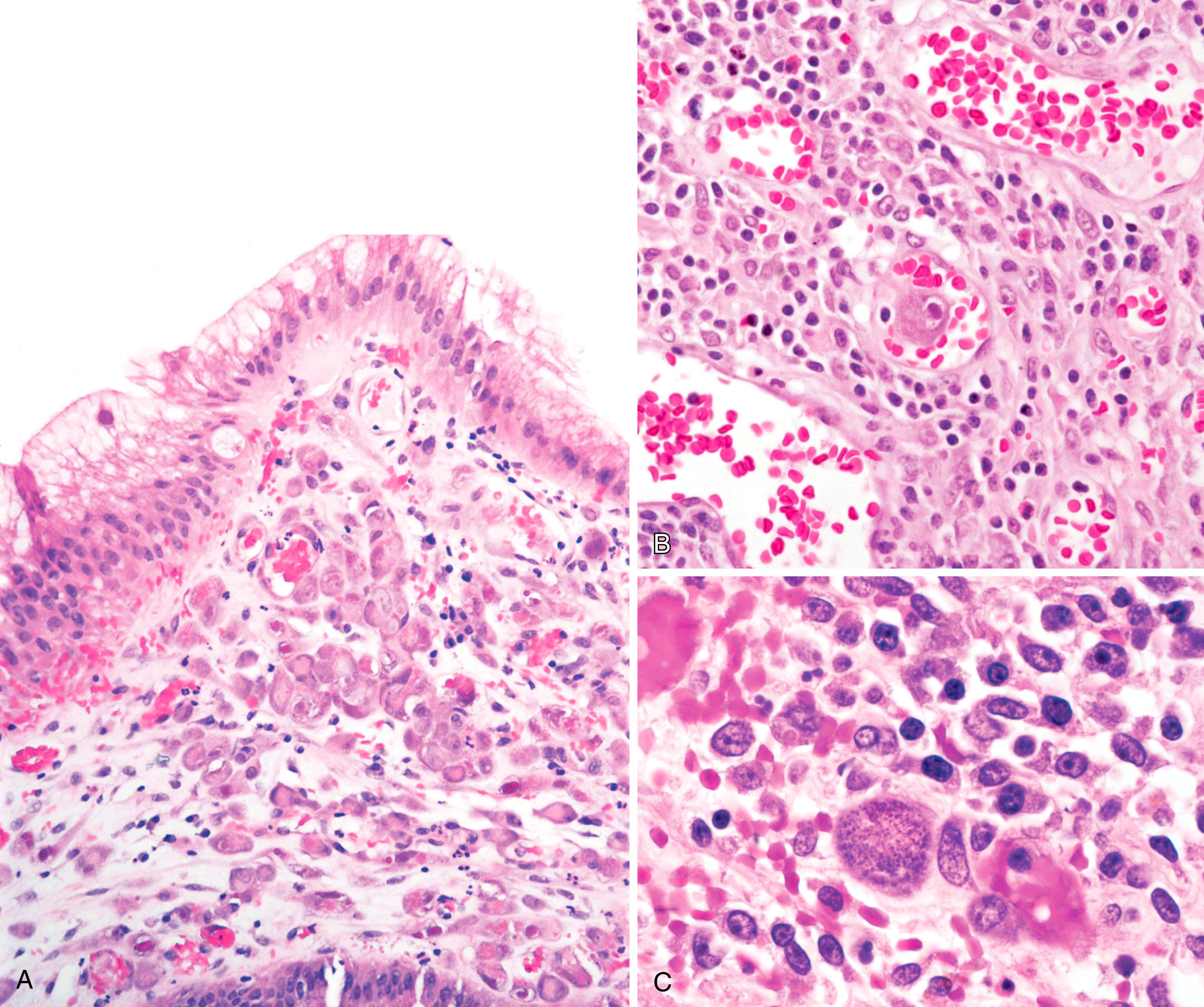
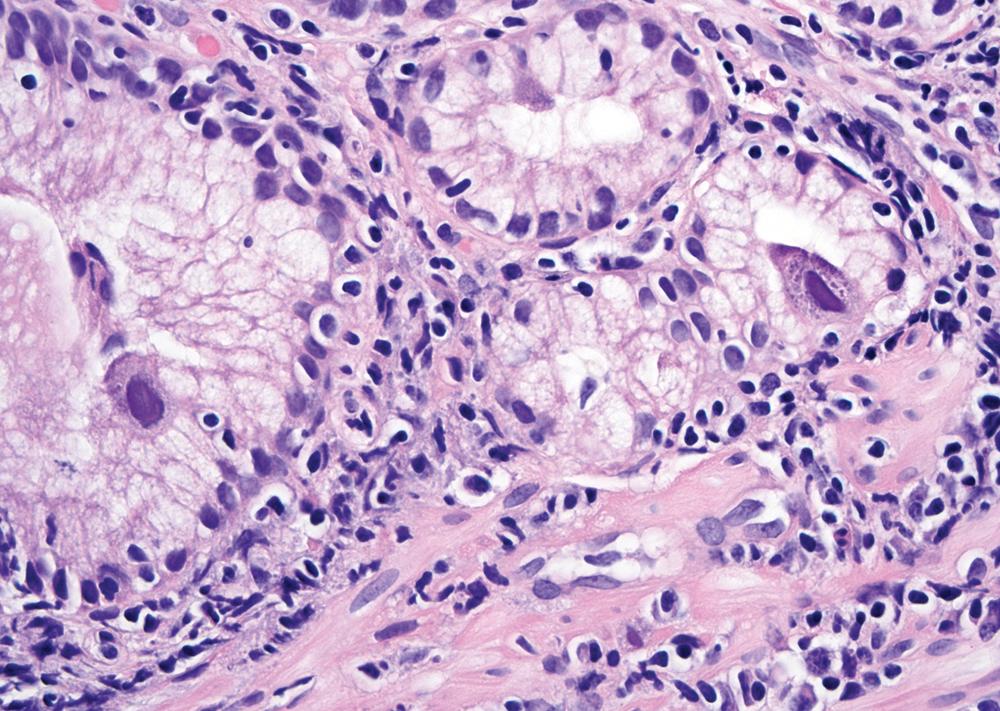
Although CMV inclusions are usually readily identifiable in routine sections, rare inclusions can be missed, particularly if exuberant inflammation obscures diagnostic findings ( Fig. 4.4A,B ). Examination of multiple levels and use of immunohistochemistry can aid in detecting scarce inclusions. On the other hand, inclusions are rarely found in uninflamed mucosae, even when immunohistochemistry is employed. Because even single CMV inclusions may prove to be clinically important, pathologists should investigate the possibility of CMV infection when other suspicious features are present.
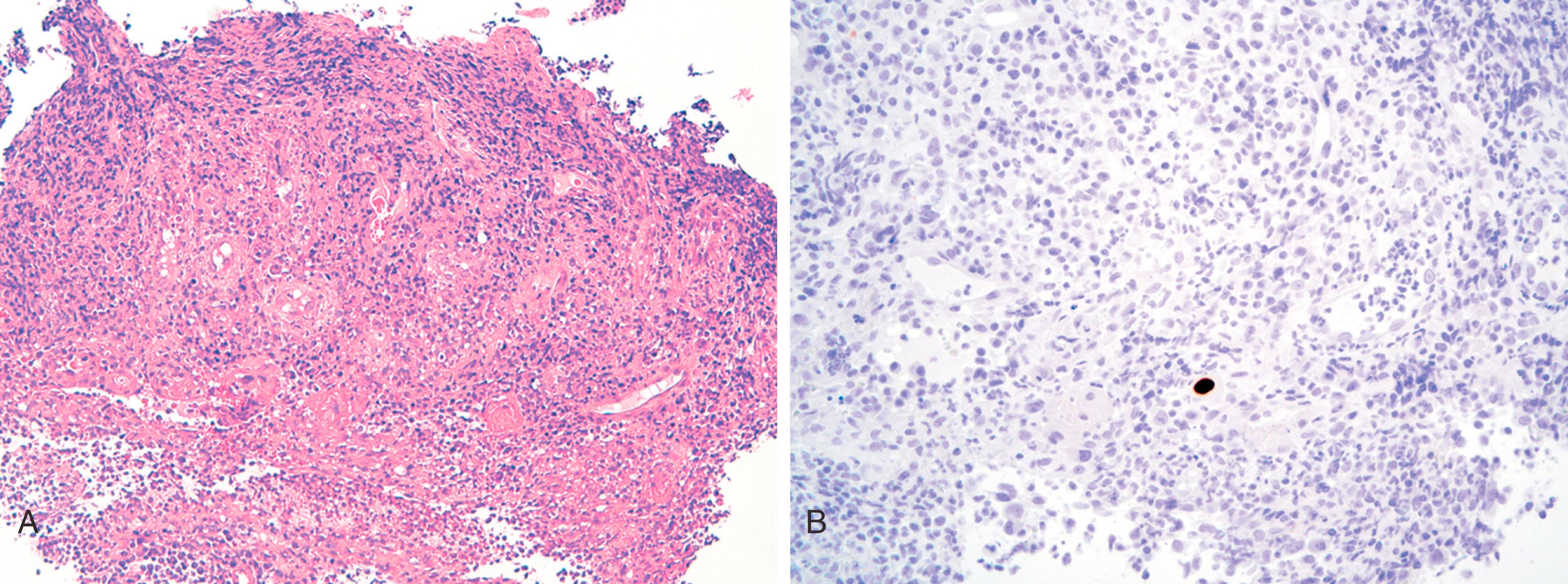
Other diagnostic aids include viral culture, polymerase chain reaction (PCR) assays, in situ hybridization, serological studies, and antigen tests. Serological studies often have limited usefulness because of the persistence of latent CMV infection. In addition, isolation of CMV in culture does not imply active infection, because the virus can be excreted for months to years after a primary infection.
The differential diagnosis of CMV includes primarily other viral infections (see Table 4.1 ), particularly adenovirus. Adenovirus inclusions are usually crescent shaped, located in surface epithelium, and only intranuclear in location. CMV inclusions are typically located in either the nucleus or cytoplasm of endothelial or stromal cells. The ballooning degeneration phase of adenovirus infection, just before cell lysis, most closely resembles CMV.
The distinction between CMV infection and graft-versus-host disease in bone marrow transplant recipients can be particularly difficult because the clinical and histological features are similar. Immunohistochemistry should be used to rule out CMV infection in this setting, because failure to identify CMV infection could result in delay of antiviral therapy. Furthermore, these conditions may coexist. Graft-versus-host disease is favored when there is abundant apoptosis associated with crypt necrosis and dropout in the setting of minimal inflammation ( Fig. 4.5 ). The presence of residual nests of endocrine cells favors graft-versus-host disease.
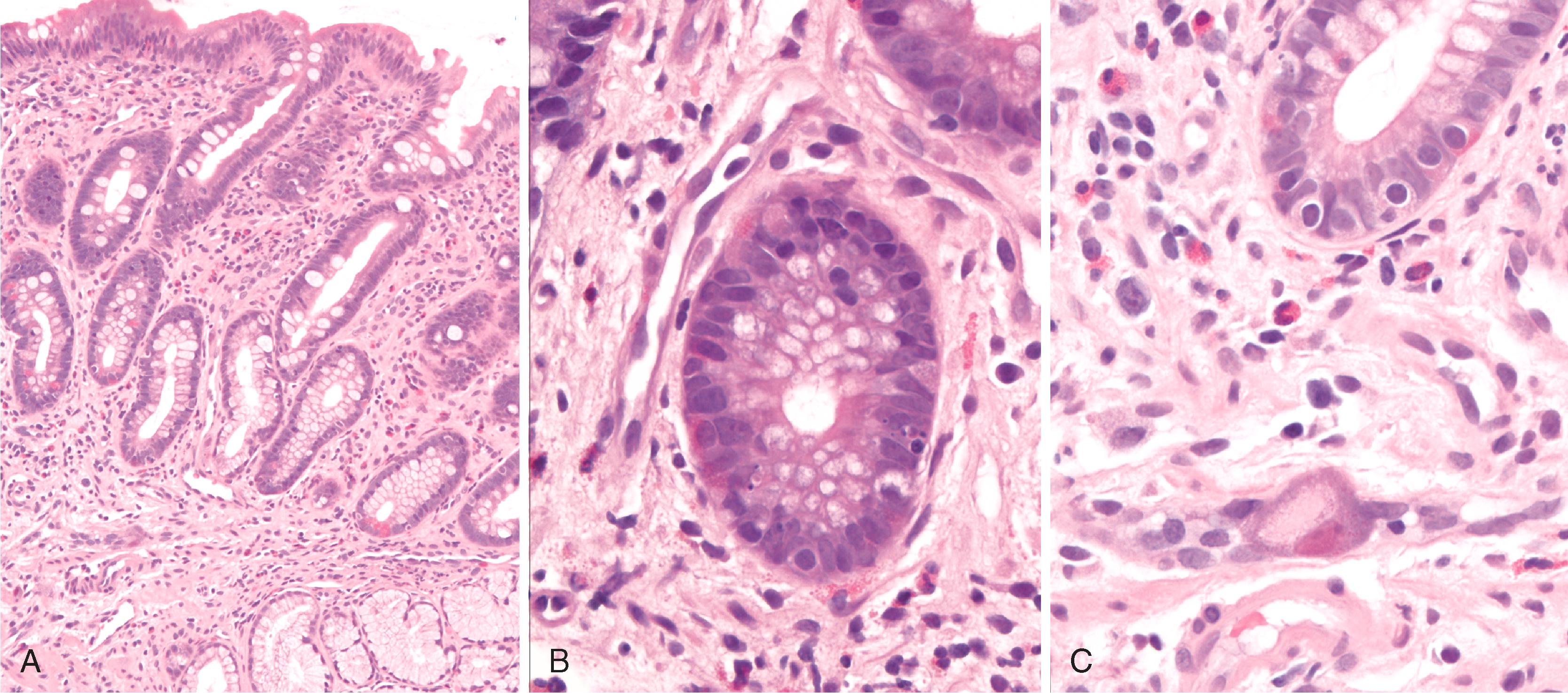
Herpetic infection can occur throughout the GI tract but is most common in the esophagus and anorectum. , Although herpes infection of the gut is often seen in immunocompromised patients and remains one of the most common infections in patients with human immunodeficiency virus (HIV) infection, it is not limited to this group. In immunocompetent patients, infection is often self-limited. Immunocompromised patients, however, are at risk for disseminated infection and life-threatening illness.
Herpetic esophagitis presents with odynophagia, dysphagia, chest pain, nausea, vomiting, fever, and GI bleeding. Many have disseminated herpes infection at the time of diagnosis. Herpetic proctitis is the most common cause of nongonococcal proctitis in homosexual men. Patients present with anorectal pain, tenesmus, constipation, discharge, hematochezia, and fever. Concomitant neurological symptoms (difficulty in urination and paresthesias of the buttocks and upper thighs) are also well described, as is inguinal lymphadenopathy.
Ulcers are the most common gross finding in the esophagus, and these are usually associated with an exudate. The ulcers are deep or shallow and often well circumscribed. Some patients have vesicles surrounding the ulcers. , Many patients have a nonspecific erosive esophagitis without discrete ulcers, however. In herpetic proctitis, the presence of perianal vesicles is common, often in association with pustules or shallow ulcers. Proctoscopic findings include ulceration and mucosal friability. Vesicles may extend into the anorectum.
Typical histological findings, regardless of site, include ulceration, neutrophils in the lamina propria, and an inflammatory exudate that often contains sloughed epithelial cells ( Fig. 4.6A ). Prominent aggregates of macrophages also may be present. In the anorectum, perivascular lymphocytic cuffing and crypt abscesses may be seen as well.

Characteristic viral inclusions and multinucleate giant cells are present in only a minority of biopsy specimens (see Fig. 4.6B,C ). The best place to search for viral inclusions is in the squamous epithelium at the edges of ulcers and in sloughed cells in the exudate. Two types of nuclear inclusions may be found: acidophilic inclusions with a surrounding clear halo and peripheral chromatin margination (Cowdry type A inclusions) and homogeneous, powdery, basophilic inclusions that replace the nucleus (Cowdry type B inclusions). Inclusion-bearing cells may be singly nucleated or multinucleated. The histological findings for herpes simplex virus 1 (HSV-1) and HSV-2 are indistinguishable.
The differential diagnosis predominantly includes other viral infections, including CMV and varicella-zoster, that may infect the GI tract (see Table 4.1 ). Varicella produces histological findings identical to those of HSV, but patients often have a rash. Mixed infections are common in many situations in which herpetic infection is found. Immunohistochemistry can distinguish the two. Viral culture and PCR are valuable diagnostic aids. Serological studies may be useful if there is a very high or rising antibody titer but have limited use because latent infections can persist for years.
Adenovirus infection is second only to rotavirus as a cause of childhood diarrhea, and it is associated with a broad spectrum of diseases in both children and adults. It has gained more attention in recent years as a cause of diarrhea in immunocompromised patients, especially those with AIDS and those who have received bone marrow or solid organ transplants. Virtually all patients experience diarrhea, sometimes accompanied by fever, weight loss, and abdominal pain. Adenovirus is also associated with ileal and cecal intussusception in children. Characteristic inclusions may be seen, especially in immunocompromised patients, in the nuclei of surface epithelial cells (particularly goblet cells); these are often accompanied by apoptotic epithelial cells and degenerative epithelial changes. Cells containing characteristic nuclear inclusions are known as “smudge cells” because of their enlarged, homogeneous, basophilic quality ( Fig. 4.7 ; see Table 4.1 ). On the other hand, adenovirus inclusions are often quite subtle and may be disregarded as reactive or degenerative cytological atypia. Immunohistochemistry, PCR, and viral serology are useful diagnostic aids ( Fig. 4.8 ). This entity is discussed further and illustrated in Chapter 5 .
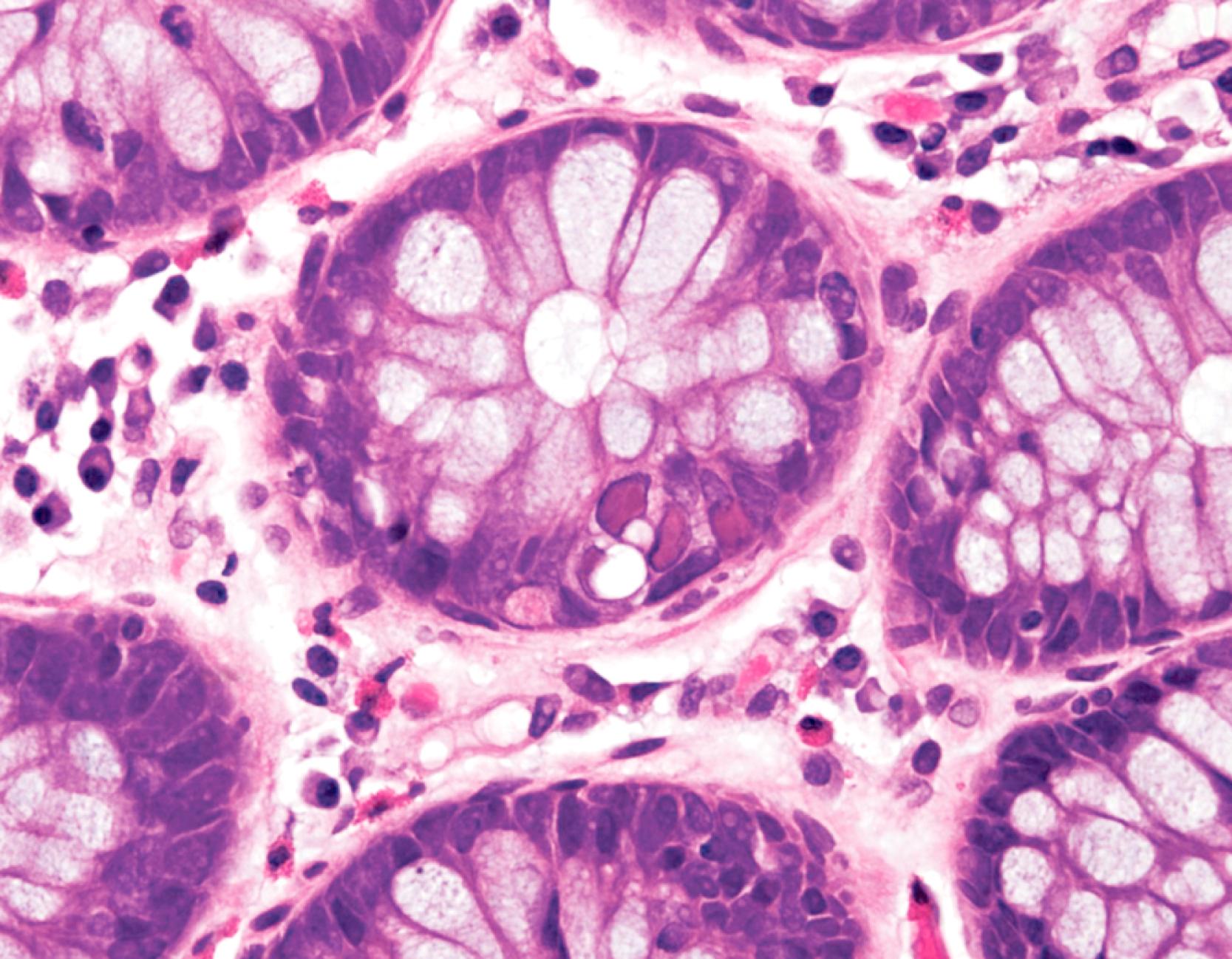
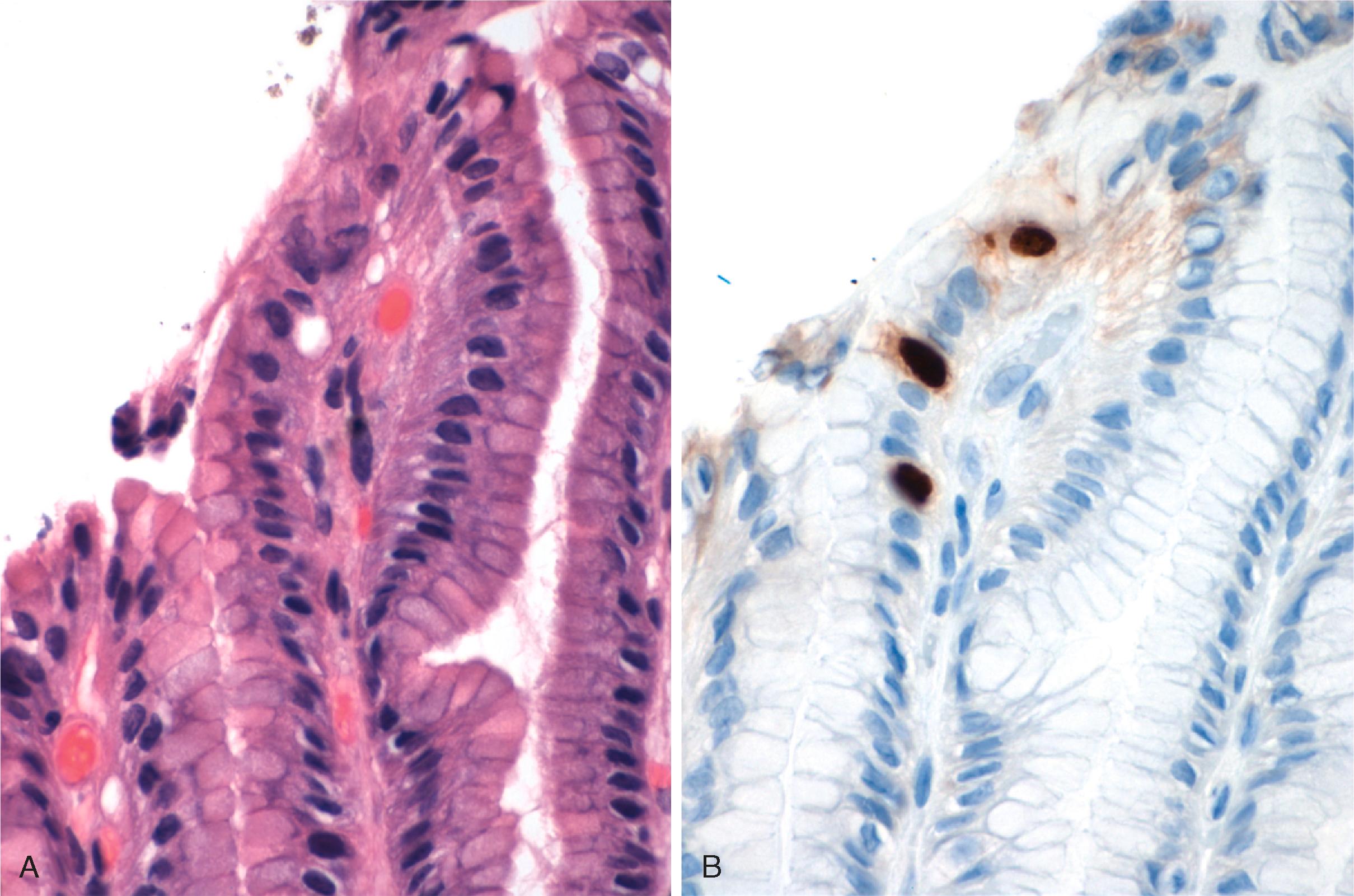
Acute viral gastroenteritis is one of the most common causes of illness worldwide. Although most infections are self-limited, viral gastroenteritis can cause severe dehydration (particularly when caused by rotavirus), as well as chronic diarrhea in children with immunodeficiency syndromes such as severe combined immunodeficiency. Enteric viral infections are a significant cause of diarrhea in patients with AIDS. Rotavirus and enterovirus, like adenovirus, are associated with intussusception in children. Many enteric viruses do not cause disease in humans; others seldom cross the stage of the surgical pathologist because they are detected in stool samples rather than biopsy specimens. Common enteric viruses known to cause diarrhea in humans include, but are not limited to, adenovirus, rotavirus, coronavirus, astrovirus, Norwalk virus, enteric caliciviruses, echovirus, and other enteroviruses. Enteric involvement was documented in the coronavirus-associated severe acute respiratory syndrome (SARS), and diarrhea was a common presenting symptom in that outbreak.
Small bowel biopsy findings include villous fusion, broadening, and blunting; crypt hypertrophy; and an increased mononuclear cell infiltrate within the lamina propria with variably present neutrophils ( Fig. 4.9 ). There also may be an increase in intraepithelial lymphocytes. Reactive and degenerative epithelial changes are usually present, particularly at the surface, including epithelial cell disarray and loss of nuclear polarity. , Increased apoptosis may be seen in surface and glandular epithelium. In the limited number of human studies available, the severity of the histological lesion does not appear to correlate with clinical severity of illness. With the exception of adenovirus infection, inclusions are not seen on light microscopy.
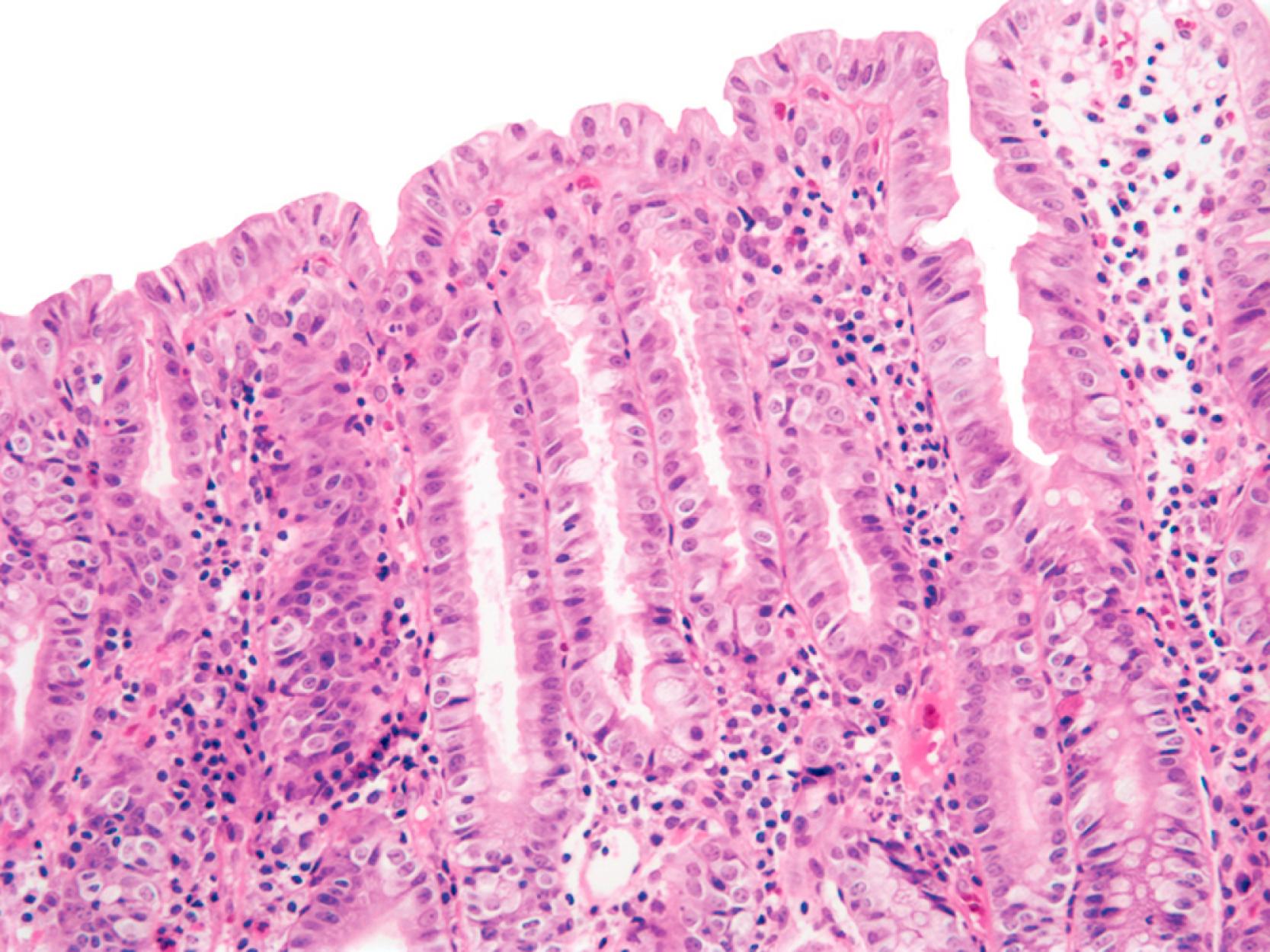
Other viruses that affect the GI tract include measles (rubeola), human herpesvirus 8 (HHV-8; also known as Kaposi sarcoma – associated herpesvirus ), HHV-6, and Epstein-Barr virus (EBV), which is associated with a wide variety of lymphoproliferative disorders. ,
Human papillomavirus (HPV) has been implicated in the pathogenesis of esophageal papillomas, esophageal squamous cell carcinomas, anal condylomas, and anal squamous cell carcinomas. These entities are discussed in detail in Chapter 19, Chapter 24, Chapter 32 .
GI disease is an important cause of morbidity and mortality in patients affected by HIV and in those with AIDS ( Table 4.2 ). Although opportunistic pathogens are often found in these patients, there is a subgroup in whom no pathogens are found despite extensive clinical and pathological evaluation. The two major disease entities associated with HIV in the absence of other demonstrable pathogens are chronic idiopathic esophageal ulcers and AIDS enterocolopathy.
| Organism | Main Sites of Involvement | Key Features |
|---|---|---|
| Viruses | ||
|
|
|
|
|
|
| Bacteria | ||
| Mycobacteria | ||
| M. tuberculosis |
|
|
|
|
|
|
Throughout colon |
|
|
|
|
| Fungi | ||
| Candida spp. |
|
|
|
|
|
|
|
|
| Protozoa | ||
| Cryptosporidium parvum | Small intestine and colon |
|
|
|
|
|
|
|
|
|
|
|
|
|
Chronic idiopathic esophageal ulcers reportedly cause approximately 30% of ulcers found in HIV-infected patients. The ability of HIV to directly cause these ulcers remains controversial, although evidence of HIV within the ulcerative lesions has been demonstrated by molecular analysis, immunohistochemical studies, and enzyme-linked immunosorbent assays (ELISAs). Patients experience severe odynophagia, chest pain, and weight loss. The middle esophagus is the most common location, followed by the distal esophagus. Endoscopically, the ulcers consist of one or more well-circumscribed lesions of variable depth that can mimic ulcers caused by other infectious agents, particularly viral pathogens. They can be quite large (>3 cm in greatest dimension) and deep, with irregular margins and overhanging, edematous edges. Mucosal bridges and sinus tract formation may occur. Histologically, the ulcers contain granulation tissue with a mixed acute and chronic inflammatory infiltrate that often contains eosinophils. By definition, special histochemical stains and immunohistochemical stains for identifiable pathogens must be negative. This finding is especially important because these ulcers are sometimes treated with steroids. This entity is also discussed in Chapter 5 .
HIV/AIDS enteropathy/colopathy is a somewhat controversial entity that has been loosely defined as the morphological changes, such as villous blunting, crypt hyperplasia, and apoptosis, seen in the gut of patients with HIV/AIDS and chronic diarrhea for which no other infectious cause has been identified. Controversy arises because asymptomatic patients may have similar morphological findings on biopsy and, conversely, severely symptomatic patients may have normal biopsies. In addition, there is always the added concern that a causative pathogen simply has been missed. Because patients with HIV/AIDS do have severe impairments of GI function, including diarrhea, malabsorption, and weight loss, even in the absence of any demonstrable pathogens, many authors support the use of the term AIDS enteropathy (or colopathy ) to describe the morphological findings, provided that the bowel has been adequately sampled and all other infectious causes have been excluded. However, other authorities think this is a poorly understood term that does not clearly represent a specific disease entity and, therefore, should be avoided.
Endoscopy and colonoscopy findings are usually normal. In the small bowel, the histological features include villous blunting and atrophy, crypt hypertrophy, increased intraepithelial lymphocytes, variably increased mononuclear cells in the lamina propria, increased mitoses within glandular epithelial cells, and increased numbers of apoptotic enterocytes at the surface and in the glands. In the colon, inflammatory changes are similar, but the apoptotic epithelial cells in the glandular epithelium are often very prominent ( Fig. 4.10 ). The changes resemble those seen in mild graft-versus-host disease and chemotherapy-related mucosal injury. Other pathogens, particularly other viruses such as CMV and adenovirus that can produce similar histological features, must be rigorously excluded.
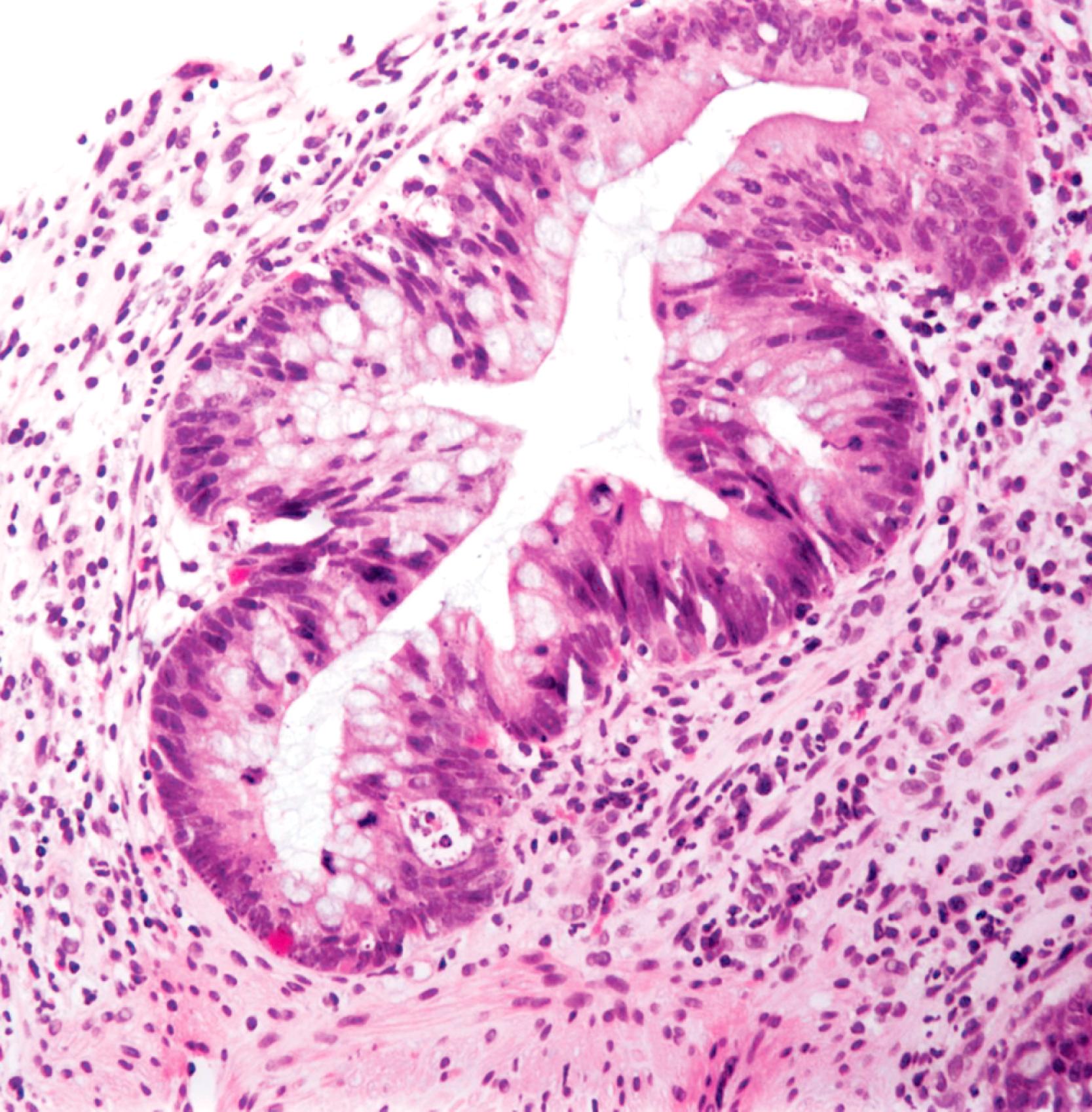
Severe acute respiratory syndrome coronavirus 2 (SARS-CoV-2) causes the illness known as COVID-19. It emerged in the Hubei province of central China in late 2019, triggering a global pandemic. COVID-19 is primarily a lower respiratory tract disease that causes fever, cough, pneumonia, and, in severe cases, respiratory failure and death. Transmission occurs via respiratory droplets. The virus uses cellular serine proteases, such as TMPRSS2, to prime its spike proteins and enters cells via the angiotensin-converting enzyme 2 (ACE2) receptor, located on pneumocytes and some enterocytes. - Up to 30% of patients with COVID-19 experience digestive symptoms, including abdominal pain, nausea, vomiting, diarrhea, and loss of appetite. , A smaller proportion first present with GI illness. An association between increased disease severity and GI involvement was found in one study; however, overall mortality is similar to that for those who do not experience GI symptoms. , There is no specific therapy for COVID-19–related diarrhea, and care is supportive.
Very little is known about the histopathological features of GI SARS-CoV-2 infection. One case of hemorrhagic diarrhea reportedly yielded normal-appearing biopsy samples. Similarly, a case in which the authors detected ACE2 protein expression by immunofluorescence in glandular epithelia appeared essentially normal in routine sections. Intestinal ischemia associated with mesenteric and small vessel thromboses, as well as pneumatosis intestinalis, are increasingly reported. , Viral RNA is detectable in stool samples of approximately half of COVID-19 patients and persists for several weeks after infection; stool samples are positive in a small subset of patients with negative respiratory swab samples. However, strong evidence for fecal-oral transmission is presently lacking.
Mild liver injury, including elevated transaminases, prolong prothrombin time, and hypoproteinemia may also occur in up to 50% of COVID-19 patients. Nonspecific features, including hepatocellular apoptosis, increased mitotic activity, and lobular inflammation are reported. It is not clear whether these findings are related to viral toxicity or effects of polypharmacy in critically ill patients.
Bacterial diarrhea is a worldwide health problem. Many bacterial infections of the gut are related to ingestion of contaminated water or food and foreign travel to areas of poor sanitation. Although bacterial pathogens are often recovered by microbial culture, surgical pathologists may play a valuable role in diagnosis. Despite the dizzying array of bacterial infections that may affect the GI tract, many produce a similar spectrum of histological features and may be generally categorized as follows ( Table 4.3 ):
Organisms that produce mild or no histological changes, such as Vibrio cholerae and Neisseria gonorrhoeae
Organisms that produce the histological features of acute infectious/self-limited colitis (ASLC) or focal active colitis (FAC), such as Campylobacter , Aeromonas , and some Salmonella spp.
Organisms that produce specific or characteristic histological features, such as pseudomembranes, granulomas, chronic colitis, or ischemia
| Inflammatory Pattern | Organism | Disease Distribution | Other Key Pathological Features |
|---|---|---|---|
| Acute self-limited colitis |
|
|
|
|
|
|
|
|
|
|
|
|
|
|
|
| Inflammatory bowel disease–like |
|
|
|
|
|
|
|
|
|
|
|
|
|
|
|
|
|
|
|
|
|
|
|
|
|
|
|
| Ischemic colitis |
|
|
|
|
|
|
|
|
|
|
|
|
|
|
|
|
|
|
|
| Minimal changes |
|
|
|
|
|
|
|
|
|
|
|
|
|
|
The ASLC pattern is the most common pattern in enteric infections. Typical histological features include neutrophils in the lamina propria, with or without crypt abscesses and cryptitis; preservation of crypt architecture; and lack of basal plasmacytosis ( Fig. 4.11 ). The acute inflammatory component is often most prominent in the middle to upper levels of the crypts. Lack of crypt distortion, Paneth cell metaplasia, and basal lymphoplasmacytosis help to distinguish ASLC from IBD ( Table 4.4 ). The changes may be focal, as in focal active colitis, or diffuse.
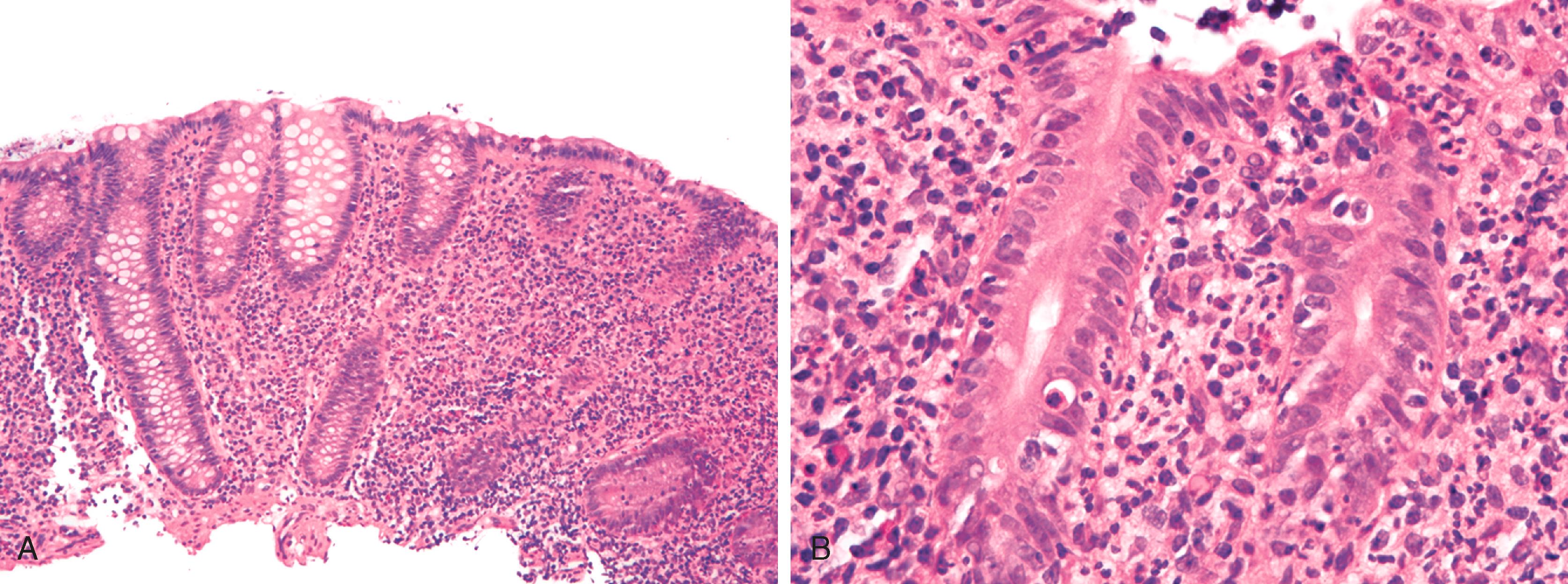
| Features | Acute Self-Limited Colitis | Inflammatory Bowel Disease Pattern |
|---|---|---|
| Presentation |
|
|
|
|
|
| Histological Features | ||
| Lamina propria inflammation |
|
|
|
|
|
|
|
|
|
|
|
|
|
|
|
|
|
Surgical pathologists should be aware of the infections that are most likely to mimic CD, UC, and ischemic colitis ( Boxes 4.1 to 4.3 , Table 4.5 ). Because most patients do not present for endoscopy until several weeks after the onset of symptoms, pathologists usually are not exposed to the classic histological features of acute infectious colitis. This is important because the resolving phase of infectious colitis is more challenging to diagnose. At this stage, only occasional foci of neutrophilic cryptitis and only patchy increases in lamina propria inflammation may be found, and these may, in fact, contain abundant plasma cells and increased intraepithelial lymphocytes, features that are also seen in CD or even lymphocytic colitis. It is important to be aware of the patient’s symptoms (particularly acute versus chronic onset) and, ideally, the culture results, because the exact diagnosis may be difficult to resolve on histological grounds alone. The pathological details of specific bacterial infections are discussed in the following sections.
Yersinia spp.
Mycobacterium tuberculosis
Salmonella typhimurium
Aeromonas spp.
Syphilis
Lymphogranuloma venereum
Shigella spp.
Nontyphoid Salmonella spp.
Aeromonas spp.
Syphilis
Lymphogranuloma venereum
Foodborne
Enterohemorrhagic Escherichia coli
Clostridium perfringens (pigbel)
Antibiotic-associated
Clostridioidies difficile
Clostridium perfringens
Klebsiella oxytoca
Neutropenia-associated
Clostridium septicum
| Features | Ischemic Colitis | Enterohemorrhagic Escherichia coli | Clostridioides difficile |
|---|---|---|---|
| Clinical setting |
|
|
|
|
|
|
|
|
|
|
|
|
|
|
|
|
|
|
|
|
|
|
|
|
|
|
|
|
|
|
|
|
|
|
|
V. cholerae (specifically the toxigenic O1 strain) is the causative agent of cholera, an important worldwide cause of watery diarrhea and dysentery that may lead to significant dehydration, electrolyte imbalance, and death within hours. Most infections result from consumption of raw or undercooked seafood, especially shellfish. Other vibrios, including non-O1 strains of V. cholerae, Vibrio vulnificans, and Vibrio parahaemolyticus, also can cause severe gastroenteritis. Vibrio hollisae, known to cause severe diarrhea, was recently reclassified as Grimontia hollisae. Symptoms of cholera include the abrupt onset of diarrhea, usually profusely watery and rarely bloody, accompanied by abdominal pain, vomiting, muscle cramps, and fever. Disseminated infection is a particularly important risk with immunocompromised patients; patients with underlying liver disease, partial or total gastrectomy, and diseases of iron metabolism are also at risk for more serious Vibrio infections.
Despite the severity of the illness, V. cholerae O1 is a noninvasive toxin-producing organism that causes minimal or no histological change to the intestinal mucosa. Nonspecific findings such as small bowel mucin depletion, degenerative surface epithelial changes, and a mild increase in lamina propria mononuclear cells have been rarely reported. , Nontoxigenic O1 and other non- cholerae Vibrio spp. may show erosive enterocolitis with active neutrophilic inflammation and associated hemorrhage. Stool and blood cultures are the mainstays of clinical diagnosis. ,
Initially thought to be nonpathogenic gram-negative bacteria, Aeromonas and related species are increasingly recognized as causes of gastroenteritis in both children and adults, and elaborate toxins similar to those of better-recognized pathogens, such as Shigella spp. Aeromonas hydrophila, Aeromonas caviae, and Aeromonas sobria most often cause GI disease in humans. Infection usually is caused by exposure to untreated water but also may result from consumption of contaminated foods such as produce, meat, and dairy products. Infections most frequently occur in the late spring, summer, and early fall, and children are most commonly affected. A mild, self-limited diarrheal illness is most common, sometimes accompanied by nausea, vomiting, and cramping abdominal pain. A more severe, dysentery-like illness occurs in 15% to 25% of patients, featuring bloody or mucoid diarrhea and fecal leukocytes. This variant is most likely to mimic chronic idiopathic IBD endoscopically.
Endoscopic findings include mucosal edema, friability, erosions, exudates, and loss of vascular pattern. The distribution is often segmental, either right- or left-sided, and may mimic CD ( Table 4.6 ). , The histological features are usually those of ASLC, including cryptitis, crypt abscesses, and a neutrophilic infiltrate in the lamina propria. However, ulceration and focal architectural distortion may be seen in some cases ( Fig. 4.12 ).
| Features | Crohn’s Disease | Yersinia spp. | Mycoplasma tuberculosis | Salmonella typhimurium | Aeromonas | Syphilis and Lymphogranuloma venereum |
|---|---|---|---|---|---|---|
|
|
|
|
|
|
|
|
|
|
|
|
|
|
|
|
|
|
|
|
|
|
|
|
|
|
|
|
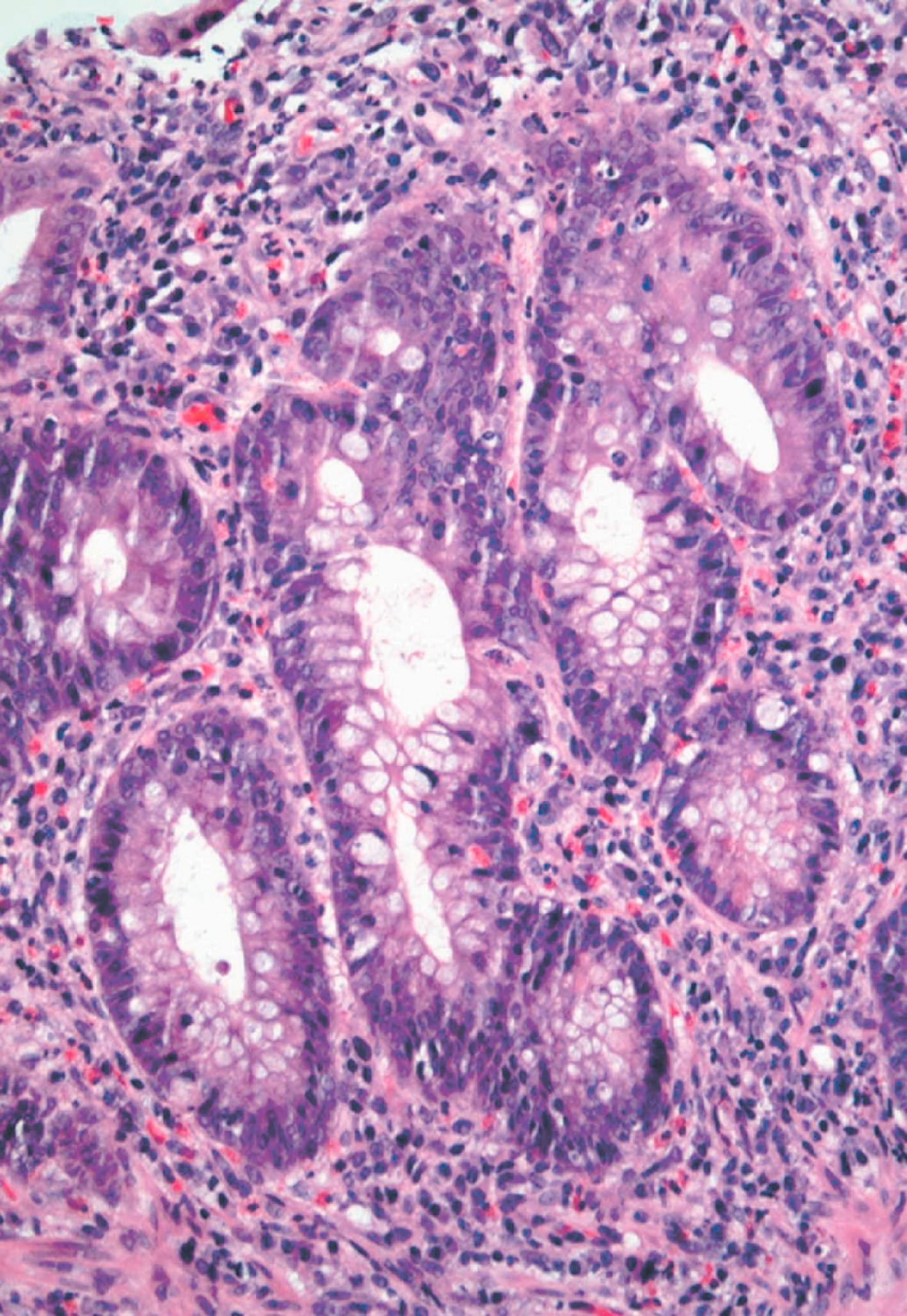
The differential diagnosis includes other infectious colitides and chronic idiopathic IBD. When architectural distortion is present in a patient with more chronic symptoms or macroscopic features mimicking chronic idiopathic IBD, it may be difficult to resolve the issue of Aeromonas infection versus CD or UC. Although there are no histological features specific for Aeromonas infection, it is important for the surgical pathologist to realize that this is one of the bacteria that can most closely mimic chronic idiopathic IBD. Stool cultures are critical to diagnosis, and certain selective media may be required.
Escherichia coli is the most common gram-negative human pathogen. The diarrheogenic E. coli are classified into five groups, based primarily on serotyping ( Box 4.4 ). , If pathogenic E. coli is suspected, the clinical laboratory should be notified to search for it specifically, because it may be missed on routine culture. In addition, because pathogenic E. coli strains are often cleared rapidly from stool (often within 4 to 7 days), cultures should be taken as early as possible.
Foodborne gram negative bacilli
Most common cause of bacteria-associated diarrhea worldwide
Cattle are largest reservoir
Fecal-oral transmission in humans
Noninvasive, colonize small intestine
Cause secretory diarrhea
Affect travelers, and infants
Pathological features not well described
Mucoid, watery, but nonbloody diarrhea
Affects travelers and AIDS patients
Pathological features not well described, but may be similar to shigellosis given genetic similarity
Adherent, but noninvasive, to the right colon
Diarrhea and wasting in AIDS patients
Fringe-like bacteria adherent to surface with little inflammation
Shiga toxin–producing strain
Causes severe bloody diarrhea, hemolytic uremic syndrome, thrombotic thrombocytopenic purpura
Acute ischemic colitis–like features with fibrin thrombi and relative sparing of deep mucosa
These noninvasive organisms cause nonbloody diarrhea. Enterotoxigenic E. coli (ETEC) is a major cause of traveler’s diarrhea and of outbreaks within industrialized nations. Enteropathogenic E. coli (EPEC) is predominantly an infection of infants and neonates. The gross and microscopic pathology of ETEC and EPEC have not been well described in humans.
Enteroinvasive E. coli (EIEC) are very similar to Shigella genetically and in their clinical presentation and pathogenesis; therefore, although not well described, the pathology may be expected to be similar as well. Symptoms include diarrhea (typically mucoid and watery, but nonbloody), tenesmus, fever, malaise, and abdominal cramps. EIEC is transmitted by contaminated cheese, water, and person-to-person contact; it is also a cause of traveler’s diarrhea. The organisms produce a severe, dysentery-like illness and bacteremia; this can be a particular problem in AIDS patients.
This noninvasive strain of enteroadherent E. coli (EAEC) is similar to EPEC. Both have been increasingly recognized as causes of chronic diarrhea and wasting in AIDS patients. Although endoscopic findings are usually unremarkable, right colon biopsies more often yield pathological findings. Histological examination shows degenerated surface epithelial cells with associated intraepithelial inflammatory cells. A coating of adherent bacteria on the surface epithelium is the most prominent feature ( Fig. 4.13 ). The bacteria may be tightly or loosely adherent. The histological findings can be patchy and can resemble an exaggerated brush border; they may easily be missed at low power. In addition, specimens from infected patients may show no associated inflammatory reaction whatsoever. The main entities in the differential diagnosis are normal mucosa and spirochetosis; the bacteria in EPEC and EAEC are not spirillar, in contrast to those in spirochetosis.
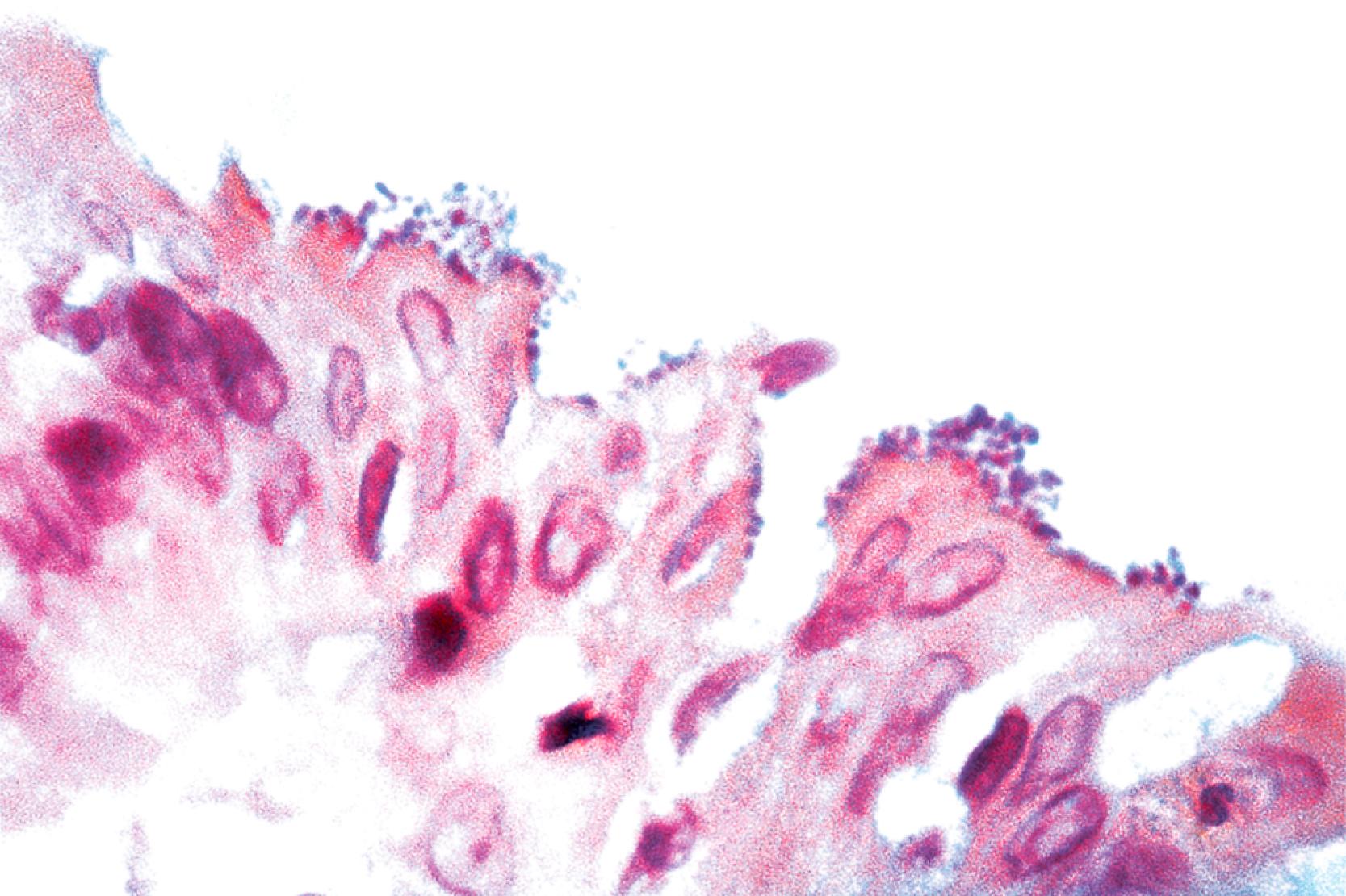
The most common strain of enterohemorrhagic E. coli (EHEC) is O157:H7. This pathogen gained national attention in 1993 when a massive outbreak in the western United States was linked to contaminated ground beef. Although contaminated meat is the most frequent mode of transmission, infection may also occur through contaminated water, milk, and produce and through person-to-person contact. EHEC produces a cytotoxin similar to that of Shigella dysenteriae, but there is no invasion. Hemolytic-uremic syndrome or thrombotic thrombocytopenic purpura may develop in affected persons, and children and the elderly are at particular risk for grave illness. In some studies, the use of antibiotics to treat EHEC appears to increase the risk for hemolytic-uremic syndrome. Symptoms usually consist of bloody diarrhea with severe abdominal cramps and mild or no fever.
Endoscopically, patients typically have severe mural edema with associated hemorrhage. The mucosa is eroded and ulcerated, and ulcers often have an overlying purulent exudate. The edema may be so marked as to cause obstruction, and surgical resection may be required to relieve this or to control bleeding. The right colon is usually most severely affected. The histological features closely resemble ischemic colitis of other causes, including marked edema and hemorrhage in the lamina propria and submucosa with associated mucosal acute inflammation, crypt withering, and lamina propria hyalinization ( Fig. 4.14 ). Microthrombi may be present within small-caliber blood vessels, and pseudomembranes resembling antibiotic-associated pseudomembranous colitis (PMC) are occasionally present as well. Mucosal necrosis is frequently seen, often involving the upper portion of the mucosa but sparing the deeper crypts. , Stool culture is invaluable in making the diagnosis; however, routine stool cultures cannot distinguish O157:H7 from normal intestinal flora, because microbiological diagnosis requires screening on selective agar. An immunohistochemical stain for the EHEC organism has been described. Fortunately, PCR-based assays are increasingly available.
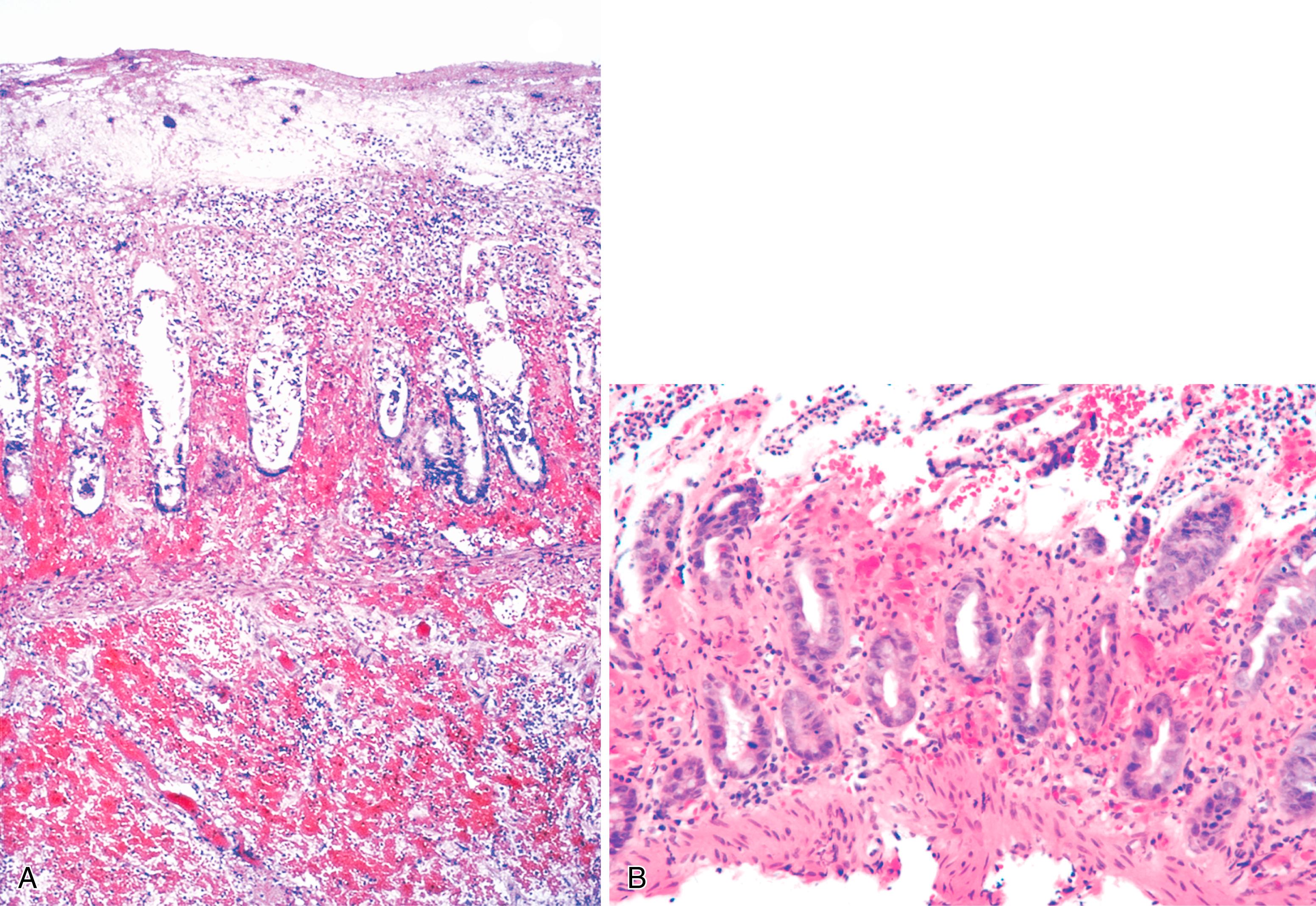
The differential diagnosis primarily includes Clostridioides difficile –related PMC and ischemic colitis of other causes, from which EHEC may be histologically indistinguishable (see Table 4.5 ). The clinical history, including the possibility of consumption of contaminated food, the age of the patient, and macroscopic findings may aid in distinguishing ischemia from E. coli infection. The C. difficile antigen test or PCR assays, or both, may be helpful, if positive.
Antibiotic-associated hemorrhagic colitis has been reported in association with Klebsiella oxytoca . This colitis is hemorrhagic, segmental, most common in the right and transverse colon, and lacks pseudomembranes. A history of penicillin therapy is key to distinguishing this infection from EHEC.
Salmonellae are gram-negative bacilli that are transmitted through food and water and are prevalent where sanitation is poor. They are an important cause of both food poisoning and traveler’s diarrhea. Human disease is caused by subspecies of S. enterica. The subspecies include typhoid and nontyphoid serovars. Enteric (typhoid) fever is usually caused by the serovar S. typhi but may also be caused by S. paratyphi; the most common nontyphoid species include S. enteritidis, S. typhimurium, S. muenchen, S. anatum, and S. give . Although historically enteric fever was considered a much more severe disease and nontyphoid salmonellosis a milder one, more recent literature suggests a greater degree of overlap (both clinically and pathologically) than previously thought. Patients with low gastric acidity are at increased risk of salmonellosis, and patients with AIDS have a greater risk of Salmonella infection and a greater likelihood of severe infection and septicemia. ,
Typhoid fever typically manifests with abdominal pain, headache, an elevation in fever over several days, and occasionally constipation. An abdominal rash and leukopenia are often seen. Diarrhea, which begins in the second or third week of infection, is initially watery but may progress to severe GI bleeding. Perforation and toxic megacolon may complicate typhoid fever.
Any level of the alimentary tract may be involved, but the characteristic pathology is associated with lymphoid aggregates and Peyer patches and therefore is most prominent in the ileum, appendix, and ascending colon. Grossly, the bowel wall is thickened and raised nodules may be seen corresponding to hyperplastic lymphoid tissue. Aphthous ulcers overlying lymphoid aggregates, linear ulcers, discoid ulcers, and full-thickness ulceration and necrosis are common as the disease progresses. Associated suppurative mesenteric lymphadenitis may occur. Occasionally, the mucosa is grossly normal or only mildly inflamed and edematous.
Macrophages are the predominant inflammatory cell. Hyperplasia of Peyer’s patches leads to acute inflammation of the overlying epithelium ( Fig. 4.15A,B ). Eventually, macrophages infiltrate and obliterate the lymphoid follicles; neutrophils are not prominent. Necrosis then begins in the Peyer’s patch and spreads to the surrounding mucosa, which eventually ulcerates. Ulcers are typically deep. Architectural distortion that may mimic UC or CD is well described (see Fig. 4.15C ). Typhoid fever occasionally shows features more consistent with ASLC, including prominent neutrophils, cryptitis, crypt abscesses, and overlying fibrinous exudate. Granulomas are occasionally seen.

Nontyphoid Salmonella infection typically manifests as a self-limited gastroenteritis. Endoscopic findings include mucosal redness, ulceration, and exudates; pathological features are those of nonspecific ASLC. Occasionally, significant crypt distortion may be seen (see Fig. 4.15D ). , ,
The differential diagnosis of typhoid fever includes other infections as well as chronic idiopathic IBD (see Box 4.2 ), and there may be significant histological overlap among these entities. A prominence of neutrophils and granulomas is rare in typhoid fever, and although significant crypt distortion has been reported in some cases of salmonellosis, it is usually more pronounced in chronic idiopathic IBD. , The differential diagnosis of nontyphoid Salmonella infection includes other causes of infectious ASLC, and occasionally chronic idiopathic IBD as well. Clinical presentation and blood and stool cultures can be invaluable to the pathologist in sorting out this differential diagnosis, and bone marrow biopsy culture may be useful in establishing the diagnosis of typhoid fever. Of note, Salmonella infection may complicate preexisting idiopathic IBD.
Shigella spp. are virulent, invasive, gram-negative bacilli that cause severe watery and bloody diarrhea and are a major cause of infectious diarrhea worldwide. Infection is transmitted by water contaminated with feces, and person-to-person transmission is also possible. It has the highest infectivity rate of the enteric gram-negative bacteria; symptoms may result from ingestion of a very low number of organisms. Children younger than 6 years of age are commonly affected, as are homosexual men and malnourished or debilitated patients. , Constitutional symptoms are the earliest manifestation and include abdominal pain, malaise, and fever. The diarrhea is often watery initially; this is followed by the onset of bloody diarrhea containing mucus or pus and accompanied by tenesmus. Complications include severe dehydration, sepsis, perforation, toxic megacolon, reactive arthritis, Reiter syndrome, and hemolytic-uremic syndrome. Chronic disease is rare.
Grossly, the large bowel is typically affected (the left side usually more severely), but the ileum may be involved. The mucosa is hemorrhagic, with exudates that may form pseudomembranes. Ulcerations are variably present. Histologically, early disease has the features of ASLC with cryptitis, crypt abscesses (often superficial), and ulceration ( Fig. 4.16 ). Pseudomembranes similar to those of Clostridioides difficile (formerly Clostridium difficile ) infection may be seen, as may aphthous ulcers similar to those seen in CD. As the disease continues, increased mucosal destruction occurs with many neutrophils and other inflammatory cells in the lamina propria. Marked architectural distortion mimicking idiopathic IBD is well described.
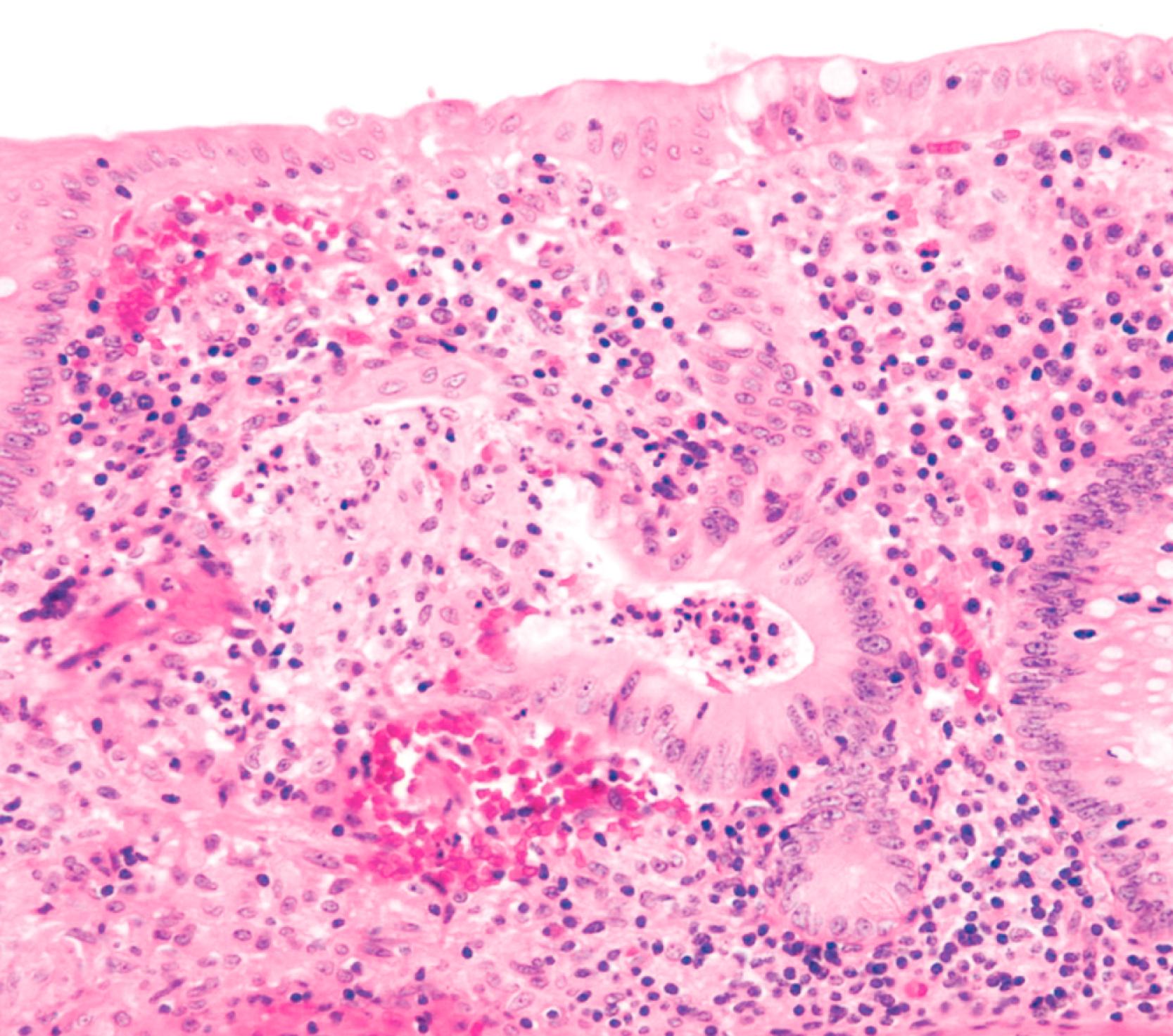
The differential diagnosis of early shigellosis is primarily that of other infections, particularly EIEC and C. difficile . Shigellosis, later in the disease course, can be extremely difficult to distinguish from UC (see Box 4.2 ), both endoscopically and histologically. Stool cultures and clinical presentation may be helpful in this instance. Multiple stool cultures may be necessary, because the organism dies rapidly and prolonged transit time may affect culture yield.
Campylobacter (the name is derived from the Greek for “curved rod”) is a genus of gram-negative bacteria that are major causes of diarrhea worldwide. Infection is most commonly associated with consumption of undercooked poultry, raw milk, or untreated water. Campylobacter jejuni is more frequently associated with food borne gastroenteritis; Campylobacter fetus and the other, less common species are more often seen in immunosuppressed patients and homosexual men. , Campylobacter infects patients of all ages, but infants, children, and young adults are most often affected. The incidence in HIV-positive patients is higher than in the general population, and severe, chronic, recurrent, or disseminated infections are more common in this group. Campylobacter infection is associated with the subsequent development of several autoimmune disorders, including Guillain-Barré syndrome, Henoch-Schönlein purpura, and reactive arthropathy. Campylobacter infection may also cause exacerbations of underlying chronic idiopathic IBD. Patients typically have fever, malaise, abdominal pain (often severe), and watery diarrhea that may contain blood and fecal leukocytes. Nausea, vomiting, tenesmus, myalgias, and headache are variably present. Symptoms typically resolve within 1 to 2 weeks, but relapse is common.
Endoscopic findings include friable colonic mucosa with associated erythema and hemorrhage. , Histological examination shows features of ASLC. Mild crypt distortion may occasionally be seen, although the architecture overall is preserved ( Fig. 4.17 ). The differential diagnosis primarily includes other forms of infectious enterocolitis that produce the acute infectious-type colitis or focal active colitis pattern. Occasionally, when crypt distortion is seen, Campylobacter colitis can mimic chronic idiopathic IBD. Cultures are useful in resolving the differential diagnosis.
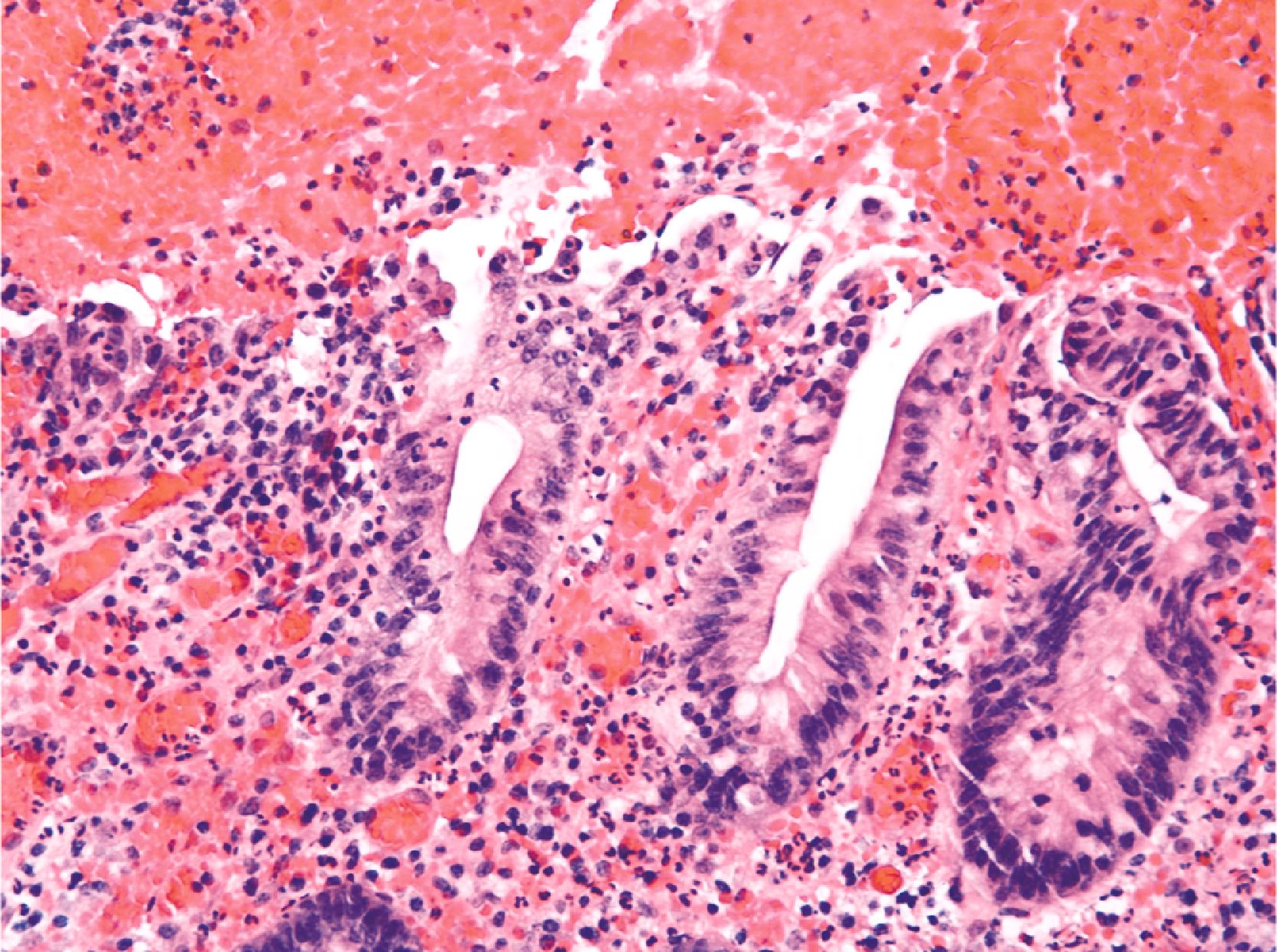
Yersinia are among the most common agents of bacterial enteritis in Western and Northern Europe, and the incidence is rising in both Europe and the United States. These gram-negative coccobacilli may cause appendicitis, ileitis, colitis, and mesenteric lymphadenitis. Although yersiniosis is usually a self-limited process, chronic infections (including chronic colitis) have been well documented. Immunocompromised and debilitated patients, children, and patients who are taking desferrioxamine or have iron overload, are at risk for serious disease. Yersinia enterocolitica and Yersinia pseudotuberculosis are the species that cause human GI disease.
Yersinia organisms preferentially involve the ileum, right colon, and appendix and may cause a pseudoappendicular syndrome. In addition, they are responsible for many cases of isolated granulomatous appendicitis. Grossly, the involved bowel has a thickened, edematous wall with nodular inflammatory masses centered on Peyer’s patches. Aphthous and linear ulcers may be seen. Involved appendices are enlarged and hyperemic, as in suppurative appendicitis; perforation is often seen. , Involved lymph nodes may show gross foci of necrosis.
Both suppurative and granulomatous patterns of inflammation are common, and these are often mixed. Significant overlap is seen between the histological features of infection with either species, and either may show epithelioid granulomas with prominent lymphoid cuffing ( Fig. 4.18A ), lymphoid hyperplasia, transmural lymphoid aggregates, mucosal ulceration, and lymph node involvement. GI infection with Y. pseudotuberculosis has been characteristically described as a granulomatous process with central microabscesses, almost always accompanied by mesenteric adenopathy (see Fig. 4.18B ). Gram stains are usually not helpful, but cultures, serological studies, and PCR assays may be useful in confirming the diagnosis.
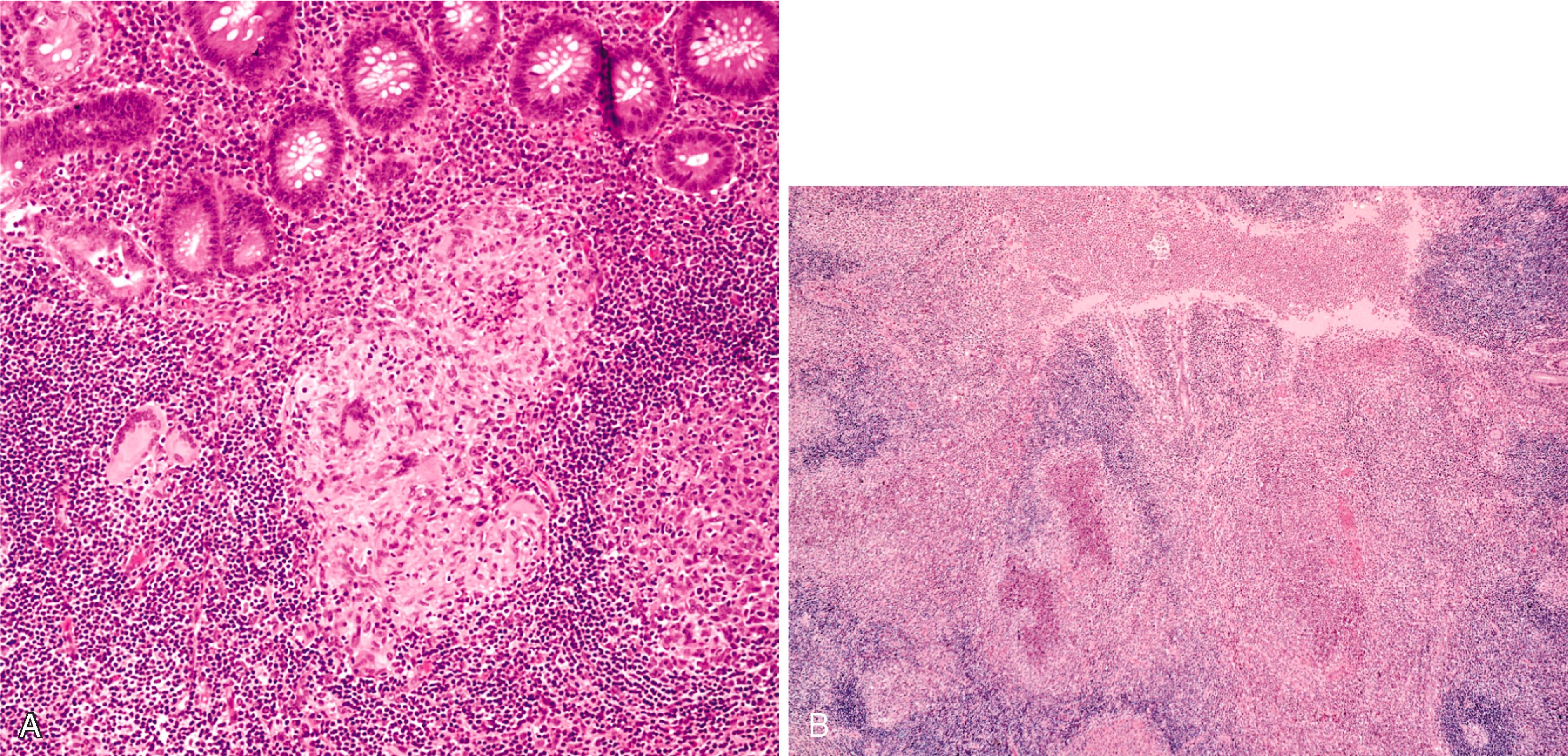
The major differential diagnosis includes other infectious processes, particularly with mycobacteria and Salmonella spp. Acid-fast stains and culture results should help distinguish mycobacterial infection; clinical features and the presence of greater numbers of neutrophils, microabscesses, and granulomas may help distinguish yersiniosis from salmonellosis.
CD and yersiniosis may be difficult to distinguish from one another, and they have a long and complicated relationship (see Table 4.6 and Box 4.1 ). They may show similar histological features, including transmural lymphoid aggregates, skip lesions, and fissuring ulcers. In fact, isolated granulomatous appendicitis has in the past frequently been interpreted as primary CD of the appendix. However, generalized IBD rarely develops in patients with granulomatous inflammation confined to the appendix. , Features that favor a diagnosis of CD include cobblestoning of mucosa and creeping fat, grossly, and microscopic changes of chronicity, including crypt distortion, thickening of the muscularis mucosae, and prominent neural hyperplasia. However, some cases are indistinguishable on histological grounds alone.
Clostridial organisms are some of the most potent toxigenic bacteria in existence. Members of this group of bacteria are responsible for PMC/antibiotic-associated colitis (usually C. difficile ); necrotizing jejunitis (usually Clostridium perfringens [formerly Clostridium welchii ]); neutropenic enterocolitis or typhlitis (often Clostridium septicum ), a serious complication of both chemotherapy-associated and primary neutropenia; and botulism ( Clostridium botulinum ) ( Table 4.7 ).
| Features | Clostridioides difficile | Clostridium perfringens | Clostridium septicum |
|---|---|---|---|
| Source |
|
|
|
|
|
|
|
|
|
|
|
|
|
|
|
Become a Clinical Tree membership for Full access and enjoy Unlimited articles
If you are a member. Log in here